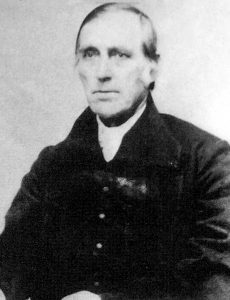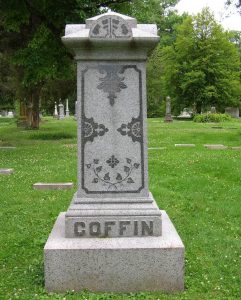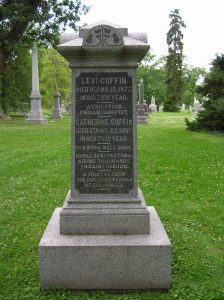
Levi Coffin was descended from the early Quaker settlers in Nantucket. His grandparents and father moved from there to New Garden, North Carolina, where Levi was born. Although his family never owned slaves, Coffin was exposed to the practice at an early age. His conversion to abolitionism occurred when he was seven years old and had an encounter with a chain gang. When his father asked one of the men why they were chained, the man replied that they were being taken from their wives and children, and the chains were to prevent them from escaping. This experience awakened in young Levi Coffin an empathy for the oppressed that would affect the course of his entire life.
In 1826, Coffin and his wife, Catherine White, relocated to Newport, Indiana. Not long after their arrival, he made his home available as a hiding place for runaway slaves.
As the owner of a dry goods store, Coffin was concerned to realize that many of the articles he sold were produced by slave labor, and he began to carry only items that were produced by free (non-slave) labor. His experience in this area led the Free Produce Association to ask him to move to Cincinnati and operate a wholesale business that carried only free labor goods. Once in town, his home once again became a safe house for fugitive slaves.
Although Cincinnati Friends shared Coffin’s opposition to slavery, it took some time before he became a member of the meeting. His children, 19-year-old Henry and 12-year-old Sarah Emaline, did not become members until 1855, after the reunion of Indiana Yearly Meeting and the Indiana Yearly Meeting of Anti-Slavery Friends. Coffin himself applied for membership in October of 1858, but the following January the committee appointed to visit him was “united in judgment that the present is not a proper time to accede to his request.” He finally became a member in 1866, was appointed an Elder in 1871, and became a very active participant in the life of the meeting thereafter.
In 1874, Levi and Catherine celebrated their 50th wedding anniversary and Levi’s 76th birthday at the meetinghouse on Eighth and Mound. When Levi passed away in 1877, his memorial service was held there as well. The building could not accommodate everyone who wanted to attend, and hundreds had to remain outside. Four of his eight pallbearers were free black men who had worked with Coffin in the Underground Railroad.
After Levi's passing, numerous members of the African-American community in Cincinnati held fundraisers for a memorial for him. No action appeared to have been taken at that time, but in 1901, Cincinnati Friends Meeting was informed that "persons not in membership with us desire to erect a monument to the late Levi Coffin on our lot in Spring Grove Cemetery." There were, at the time, concerns about this, in light of the long-standing Quaker tradition of maintaining simplicity in grave markers. Nevertheless, the Trustees and Burial Committee relented. The six-foot marker, which still stands in Spring Grove, was unveiled on May 30, 1902, and bears the following inscription:

Levi Coffin
Died 9th Mo. 16, 1877
In His 79th Year
A Christian
Philanthropist
Catherine Coffin
Died 5th Mo. 22, 1881
In Her 78th Year
Her Work Well Done
Noble benefactors
Aiding Thousands
To Gain Freedom
A Tribute From
The Colored People
Of Cincinnati
